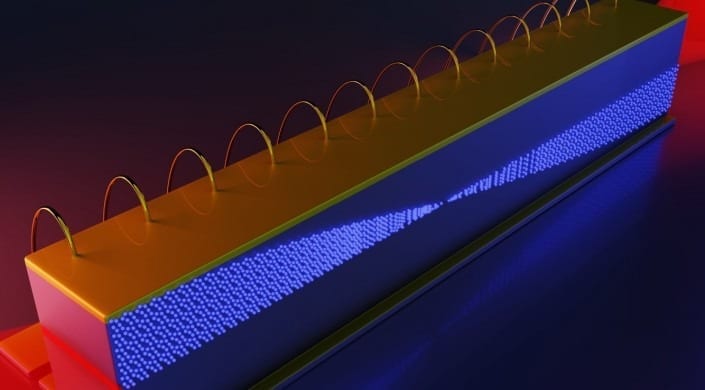
A team of physicists has uncovered properties of a category of magnetic waves relevant to the development of neuromorphic computing–an artificial intelligence system that seeks to mimic human-brain function.
“As we continue to pioneer novel computing paradigms, understanding the characteristics and promise of their building blocks is essential,” explains Andrew Kent, a physicist at New York University who led the research team. “Our findings reveal how one of these components act, which is the next step in helping realize their potential.”
The research, which appears in the journal Scientific Reports, also included scientists from the University of Barcelona and the Institute of Materials Science of Barcelona. Its lead authors were Jinting Hang, an NYU physics graduate student, and Christian Hahn, an NYU postdoctoral fellow who presently works at Physikalisch-Technische Bundesanstalt (PTB) in Germany.
Kent and his colleagues previously imaged magnetic solitons, a then-undetected magnetic wave, which offer the possibility to serve as an energy-efficient means to transfer data in consumer electronics.
Solitons, or solitary waves, were theorized to occur in magnets in the 1970s. They form because of a delicate balance of magnetic forces–much like water waves can form a tsunami. These magnetic waves can potentially be harnessed to transmit data in magnetic circuits in a way that is far more energy efficient than current methods that involve moving electrical charge.
In the Scientific Reports study, the scientists examined a specific type of soliton–a magnetic droplet, which is dynamic; the magnetic waves that make up this kind of soliton oscillate rapidly.
In their work, the researchers unearthed some of these droplet solitons’ functionality–specifically, how far or long solitons can propagate without dissipating and how long they take to form.
“This category of solitons may be important to the development of brain-inspired computing systems,” explains Kent. “For example, they function as oscillators with a memory and thus mimic some characteristics of neurons.”
A video of this process may be viewed here. It shows a magnetic droplet orbiting an electrical contact to a thin magnetic layer. The perimeter of the contact is shown by the blue circle. The magnetic moments in the droplet oscillate very rapidly compared to the time it takes for the droplet to complete an orbit. Like water drops, a magnetic droplet will evaporate, or disappear, when no longer sustained by an electrical current.
Learn more: Physicists find properties of magnetic soliton of interest for brain-inspired computing
The Latest on: Neuromorphic computing
[google_news title=”” keyword=”neuromorphic computing” num_posts=”10″ blurb_length=”0″ show_thumb=”left”]
via Google News
The Latest on: Neuromorphic computing
- DEA looks to reclassify marijunana as less dangerous drug. What does that mean for the DMV?on May 1, 2024 at 3:04 pm
The federal government is planning to ease restrictions on marijuana by reclassifying the drug and its possible uses.
- Smart Drugson April 15, 2024 at 9:08 am
In this cinematic one-off POV documentary, we follow Nik Badminton on a journey down the rabbit hole into the world of smart drugs and cognitive enhancement techniques as he tries to better his ...
- Smart Drug Delivery Market Soars with 14.9% CAGR Predictionon April 10, 2024 at 5:00 pm
According to a recent report by Market.us, the Global Smart Drug Delivery System Market size is expected to be worth around USD 32.5 Billion by 2032 from USD 9.7 Billion in 2023, growing at a CAGR of ...
- The dark side of medications: These drugs do more harm than goodon April 3, 2024 at 6:52 am
One such method is the use of ADHD drugs, commonly prescribed for attention deficit hyperactivity disorder. These “smart” drugs are believed to enhance focus and cognitive abilities.
- Nootropics: What Nootropic Supplements Can Do for Youon December 20, 2023 at 9:02 am
Nootropics (also known as smart drugs or cognitive enhancers) have emerged as a viable solution for boosting brain performance. This article introduces the world of nootropics, exploring what ...
- Can a Pill Make You Smarter?on March 27, 2023 at 7:31 am
Hausman hastens to add that his company has no interest in developing Phenserine as a "smart drug," for use in normal people. "I don't know if the FDA would ever allow a normal memory drug," he says.
- Modalert vs. Modvigil vs. Waklert vs. Artvigil: Detailed Reviewon January 8, 2021 at 8:07 am
In 2018, the smart drug market was valued at around $1.96 billion. However, it is expected to increase by a staggering 13.2% per annum and reach $5.32 billion by 2026. The fact of the matter is ...
- Smart Drugson August 6, 2020 at 12:54 pm
He takes smart drugs, tries fasting, and tests out the latest trends, but can his body keep up? Unfortunately Smart Drugs isn't available to watch right now. Add it to your list and we'll let you ...
- “Smart drugs” and cold therapy: How I’m biohacking my body to be smarter and healthieron May 8, 2019 at 7:10 am
I had fooled around with things like fasting, smart drugs/nootropics and microchip implants in the past, but now I was ready to seriously commit. Here are a few things I tried and liked ...
via Bing News










